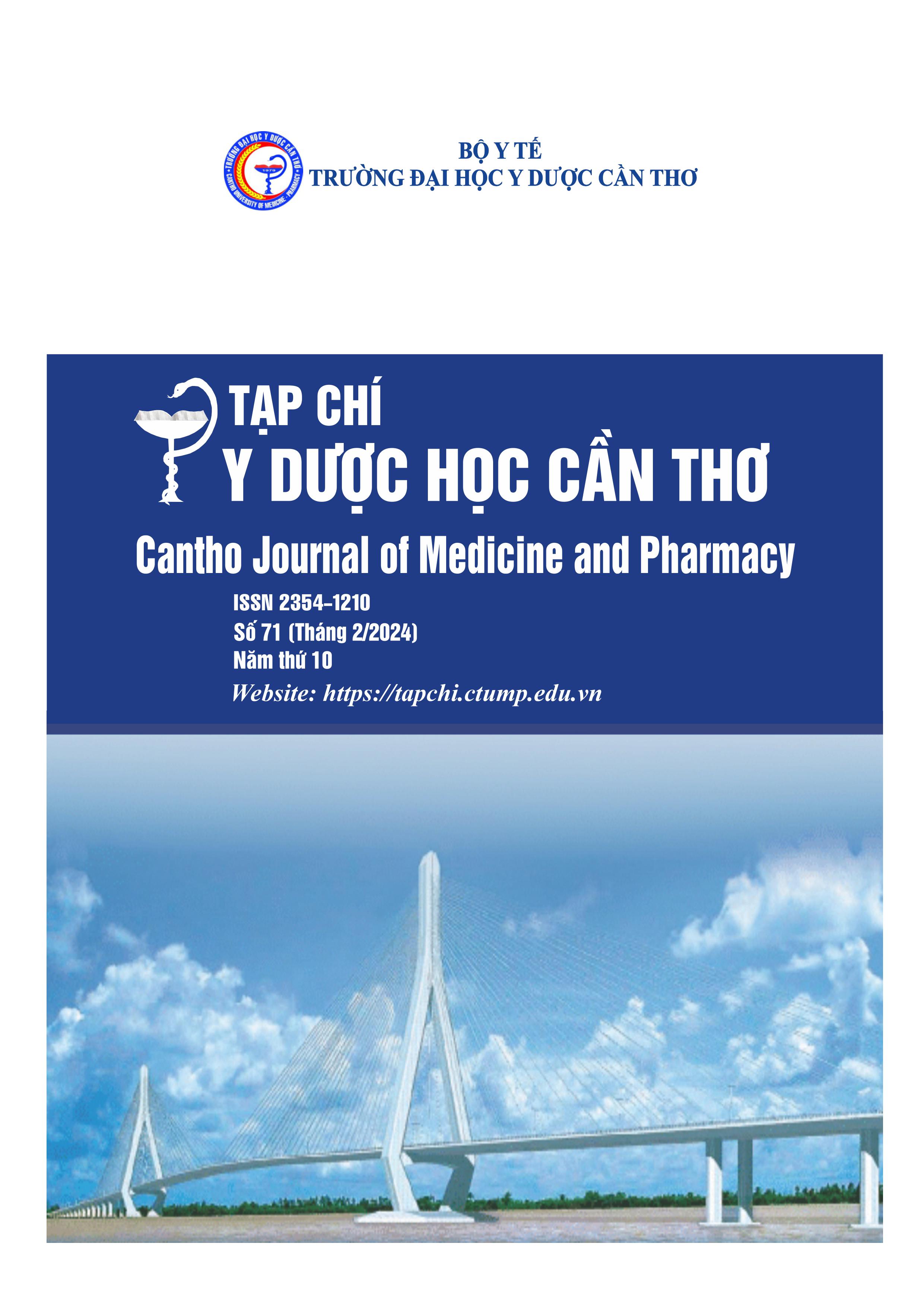HISTOPATHOLOGICAL CHARACTERISTICS OF THE GASTRIC MUCOSA IN CHILDREN WITH HELICOBACTER PYLORI POSITIVE GASTRITIS AND PEPTIC ULCER
Main Article Content
Abstract
Background: Diagnosis of gastric and duodenal inflammation and ulcers caused by H. pylori need to be based on endoscopic images and histopathological examination of biopsy pieces of the gastric mucosa. Among these, histopathological testing plays an important role in diagnosing grading of gastric inflammation and H. pylori density. Objectives: To determine the rate of histopathological lesions to the gastric mucosa and associated factors in pediatric patients with gastric and duodenal ulcers and inflammation. Materials and methods: The cross-sectional study was conducted at Can Tho Children's Hospital from January 2021 - January 2023 in 110 pediatric patients. We performed esophagogastroduodenoscopy to observe and biopsy the gastric mucosa and do histopathological testing. Results: The mild density of H. pylori bacteria are 63.6%, moderate is 21.8%, and severe is 14.5%. Chronic active inflammation accounts for 77.3%, atrophic inflammation accounts for 14.5% and intestinal metaplasia accounts for 0.9%. Conclusion: The common histopathological lesion of the gastric mucosa is chronic active inflammation, atrophic inflammation and intestinal metaplasia are less popular. There is a relationship between abdominal pain, moderate-severe H. pylori density and active chronic inflammation.
Article Details
Keywords
Gastric and duodenal ulcers, Helicobacter pylori, histopathology, children
References
2. Correa P. and Piazuelo M.B. The gastric precancerous cascade. Journal of Digestive Diseases. 2012. 13(1), 2–9, doi: 10.1111/j.1751-2980.2011.00550.x.
3. Tytgat GN. The Sydney System: endoscopic division. Endoscopic appearances in gastritis/duodenitis. Journal of gastroenterology and hepatology. May-Jun 1991;6(3):223-34. doi:10.1111/j.1440-1746.1991.tb01469.
4. Dixon MF, Genta RM, Yardley JH, Correa, P. Classification and grading of gastritis. The updated Sydney System. International Workshop on the Histopathology of Gastritis, Houston 1994. The American journal of surgical pathology. Oct 1996;20(10):1161-81. doi:10.1097/00000478-199610000-00001.
5. Tăng Lê Châu Ngọc, Nguyễn Anh Tuấn, Nguyễn Minh Ngọc, Nguyễn Trọng Trí, Võ Hoàng
Khoa và cộng sự. Đặc điểm đề kháng kháng sinh và đáp ứng điều trị trên trẻ viêm dạ dày do Helicobacter Pylori. Y học Thành phố Hồ Chí minh. 2018.
6. Nguyễn Hoài Nam, Nguyễn Thị Việt Hà. Đặc điểm lâm sàng theo tổn thương mô bệnh học của viêm dạ dày mạn tính có nhiễm Helicobacter pylori ở trẻ em tại bệnh viện sản nhi nghệ an. Tạp Chí Y học Việt Nam. 2023. 529(1), https://doi.org/10.51298/vmj.v529i1.6278.
7. Abbas M., Sharif F. A., Osman S. M. & M., O. A. Prevalence and associated symptoms of
Helicobacter pylori infection among schoolchildren in Kassala State, East of Sudan.
Interdisciplinary perspectives on Infectious Diseases. 2018. 1-5, doi: 10.1155/2018/4325752.
8. Miyata, E. & Kudo, T. Eradication therapy for Helicobacter pylori infection based on the antimicrobial susceptibility test in children: A single-center study over 12 years. 2021. 26(1), e12764, https://doi.org/10.1111/hel.12764.
9. Trần Đức Long, Nguyễn Trung Kiên, Nguyễn Thị Thu Cúc. Tình hình nhiễm Helicobacter pylori, đặc điểm lâm sàng và hình ảnh nội soi ở trẻ viêm loét dạ dày tá tràng từ 6-15 tuổi tại Bệnh viện Nhi đồng Cần Thơ. Tạp chí Y Dược học Cần Thơ. 2019. 19. 1-8.
10. Shah, S. C., Iyer, P. G. & Moss S. F. AGA Clinical Practice Update on the Management of Refractory Helicobacter pylori Infection: Expert Review, Gastroenterology. 2021. 160(5), 1831-1841, https://doi.org/10.1053/j.gastro.2020.11.059.
11. Nguyễn Thị Út. Đặc điểm dịch tễ, lâm sàng và kết quả một số phác đồ điều trị viêm, loét dạ dàytá tràng do Helicobacter pylori kháng kháng sinh ở trẻ em tại Bệnh viện Nhi Trung ương. Viện Vệ sinh Dịch tễ Trung ương. 2016.
12. Đặng Thúy Hà, Phan Thị Ngọc Lan, Trần Thị Thanh Huyền, Trần Thị Thu Hiền, Phan Quốc Hoàn và cộng sự. Mối liên hệ giữa yếu tố độc lực của H. pylori và biểu hiện lâm sàng ở bệnh nhi: Những giá trị trong chỉ định điều trị. Khoa học và công nghệ Việt Nam. 2019. 61(11), 52-65.
13. Bùi Chí Nam, Vũ Văn Khiên, Phan Quốc Hoàn, Dương Xuân Nhương, Đào Trường Giang và cộng sự. Nghiên cứu đặc điểm kiểu gen cagA, VacA của vi khuẩn Helicobacter pylori và đặc điểm tổn thương mô bệnh học viêm dạ dày mạn tính của người dân tộc thiểu số Việt Nam. Tạp chí Y dược học quân sự. 2020. 1, 32-39.
14. Nguyễn Văn Ngoan. Nghiên cứu đặc điểm lâm sàng, nội soi, mô bệnh học và kết quả điều trị viêm dạ dày mạn tính do nhiễm Helicobacter pylori ở trẻ em. Đại học Y Hà Nội. 2004. 121.
15. Nguyễn Hồng Thuý. Bước đầu nhận xét sự nhiễm Helicobacter pylori trong viêm dạ dày mạn tính ở trẻ em. Đại học Y Hà Nội. 1997. 6.
16. Nguyễn Thanh Liêm, Nguyễn Bá Vượng, Đinh Thị Phương Liên, Nguyễn Văn Luân, Lê Thị Thúy Loan. Đặc điểm mô bệnh học niêm mạc dạ dày ở bệnh nhân loét tá tràng có nhiễm Helicobacter pylori. Tạp Chí Y học Việt Nam. 2023. 522(1). https://doi.org/10.51298/vmj.v522i1.4225.
17. Khulusi S., Mendall M.A., Patel P. et al. Helicobacter pylori infection density and gastric inflammation in duodenal ulcer and non-ulcer subjects. Gut. 1995. 37(3), 319–324, doi:
10.1136/gut.37.3.319.


